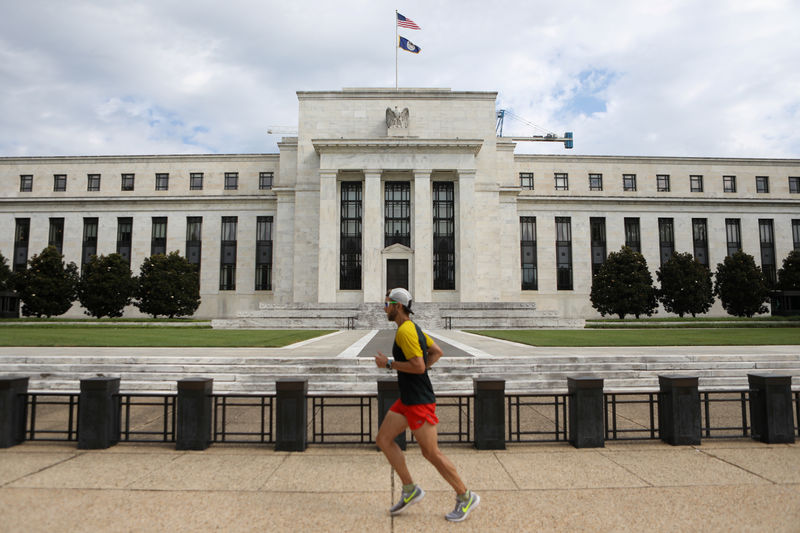(Bloomberg) -- Federal Reserve officials have said for months that price increases are temporary. On Wednesday, they weren’t so sure.
“Is there a risk that inflation will be higher than we think? Yes,” Chair Jerome Powell told a press conference. He spoke after financial markets were taken by surprise when policy makers signaled they expect to make not one, but two, hikes to interest rates in 2023 from near zero now.
The Fed has been in a tug-and-pull with investors and critics over whether recent spikes in prices as the economy reopens from the pandemic will be transitory, as officials have argued, or prove more lasting.
“There is a lot of uncertainty,” Powell said. Indeed, Fed policy makers moved up their forecasts for inflation over the next three years after a two-day meeting of the Federal Open Market Committee.
The Fed’s inflation projections -- which are above their 2% target through 2023 -- show that a majority of officials don’t want to run a lengthy test with rising prices, even though a new policy strategy they adopted in August calls for more tolerance.
Powell spelled out that while inflation had come in higher than expected of late, his base case is still that price pressures will cool as supply bottlenecks from the reopening economy are worked out and fiscal stimulus fades. He pointed to price declines in the lumber market and said he expected used-car prices to lose steam as well.
Upside Risks
The risk is that three years of above-target inflation starts to seep into public perceptions and move expectations higher. Wednesday’s meeting was largely about signaling that they aren’t going to let that happen.
“They are a lot more worried about upside risks to inflation here than they were in their comments before the meeting,” said Julia Coronado, the founding partner at MacroPolicy Perspectives LLC. “They are concerned and want to react to it.”
U.S. central bankers penciled in two rate hikes for 2023, and seven want to raise rates next year, up from four in March. All 18 officials have higher uncertainty about inflation risks, and 13 now say inflation risks are weighted to the upside, up from 5 in March.
The central bank held the target range for its benchmark policy rate unchanged at zero to 0.25% -- where it’s been since March 2020 as the Covid-19 pandemic took hold. Fed officials were “talking-about-talking-about” scaling back the $120 billion monthly pace of their bond purchases, Powell said, but he made clear that they were not close to making a decision.“The economy has clearly made progress, although, we are still a ways from our goal of substantial further progress,” he added, referring to the threshold the FOMC has set for reducing asset purchases.
Given that consumer prices rose 5% for the year ending May, that shows tapering is mainly about progress in the labor market, said Derek Tang, an economist at L.H. Meyer Monetary Policy Analytics in Washington.
“They have been quite clear on that -- it isn’t just the unemployment and payrolls, it is increasingly now about broader measures that look at shortfalls such as the employment-to-population ratio,” he said.
Still, the U.S. economy remains a perplexing puzzle when it comes to the jobs market. There are more than 9 million Americans unemployed, and more than a third of them have been jobless for 27 weeks or more. Companies are reporting labor shortages and rising wages. Job openings are rising.
Powell said he is confident that the U.S. economy is on a path over the next two years to “a labor market that shows low unemployment, high participation, rising wages for people across the spectrum.” More available day care and reopening schools could bring women back to the labor force, while the end of enhanced unemployment benefits in September could bring more people off the sidelines.
Restoring that pre-pandemic labor market is what Powell has been talking about since the start of the Covid crisis. It was the reason for the Fed’s emergency lending facilities and his endorsement of certain fiscal measures. He wants as many Americans as possible back in work, as soon as possible. And officials forecast the unemployment rate to return to the pre-pandemic low of 3.5% by the fourth quarter of 2023.
So on the issue of tapering asset purchases, economists view that decision as more closely linked to data on jobs after Wednesday’s decision. And on inflation, the Fed has said it’s prepared to signal it will take action once labor market gains are secure..
“The reason for the committee moving a bit in this direction is risk management,” said Jonathan Wright, an economics professor at Johns Hopkins University and a former Fed economist. “The risks of overheating are a bit greater than they were.”
©2021 Bloomberg L.P.
